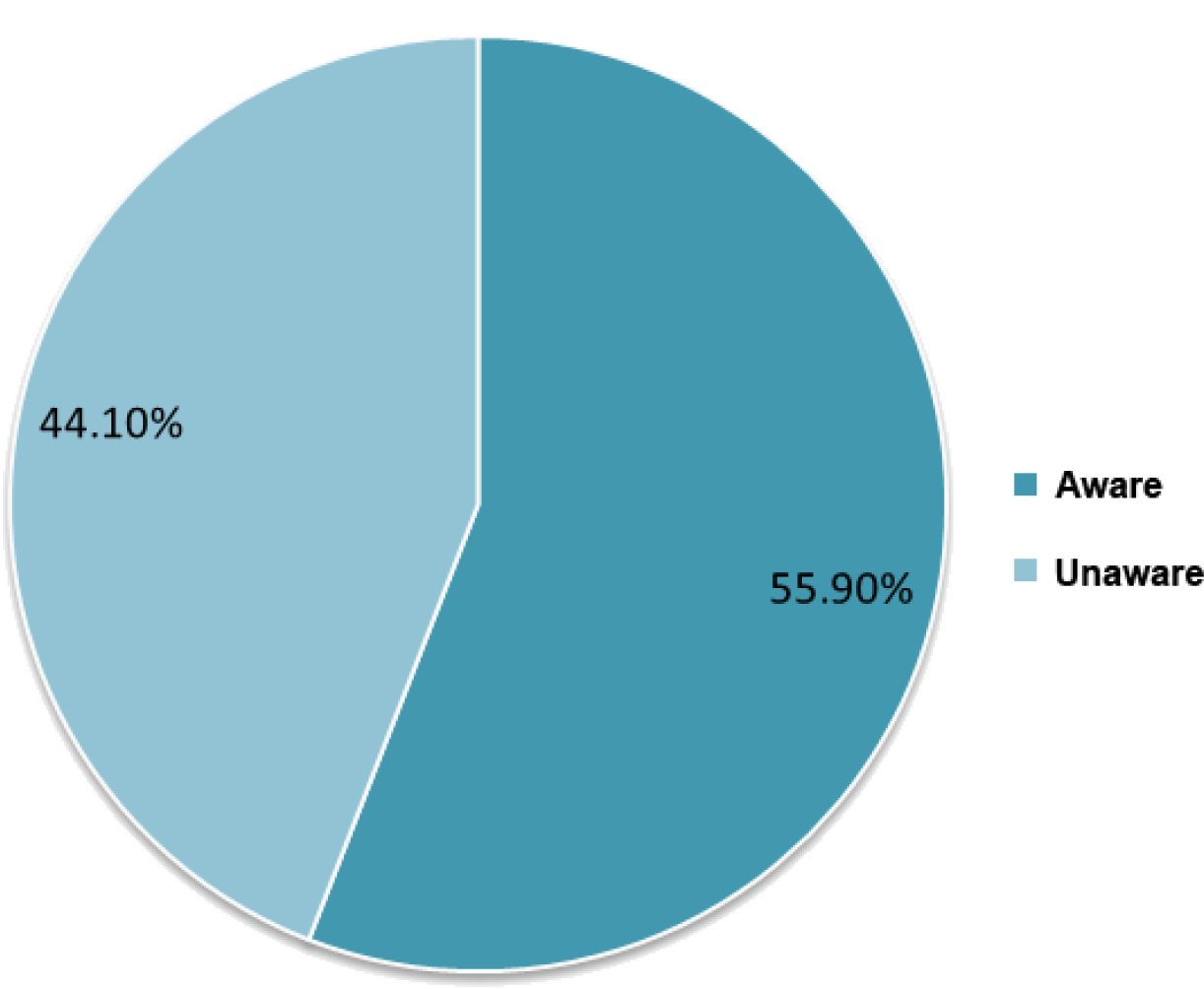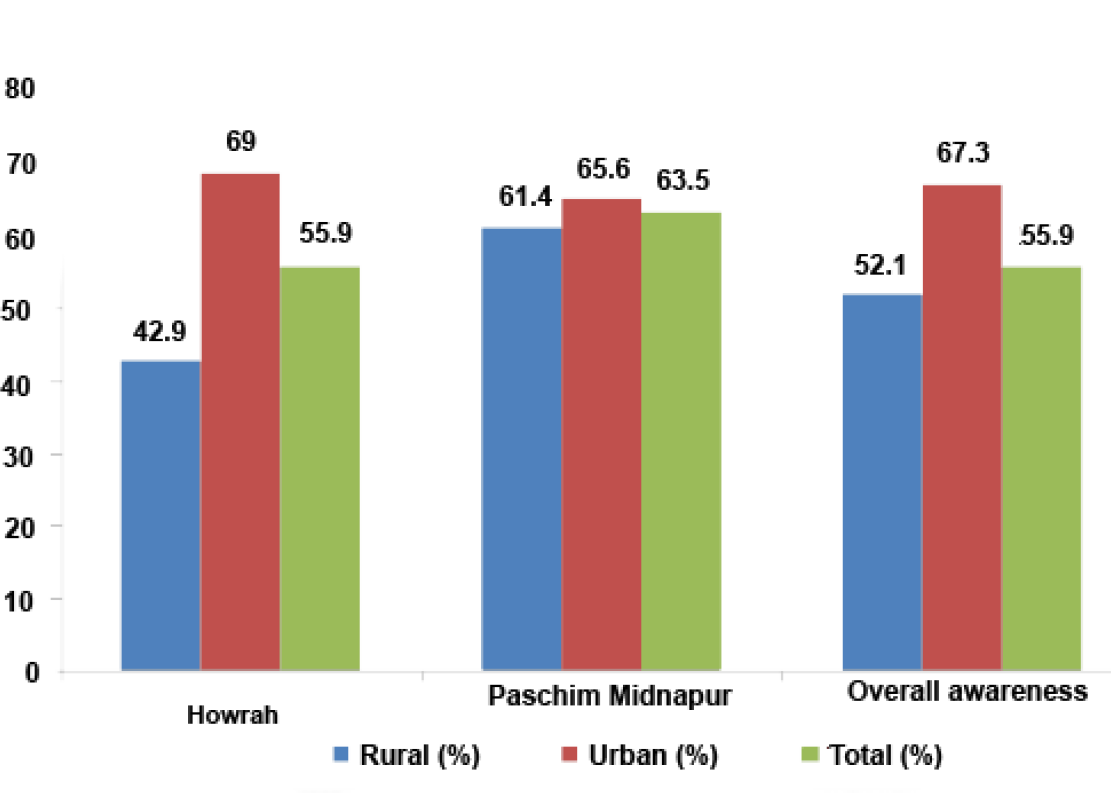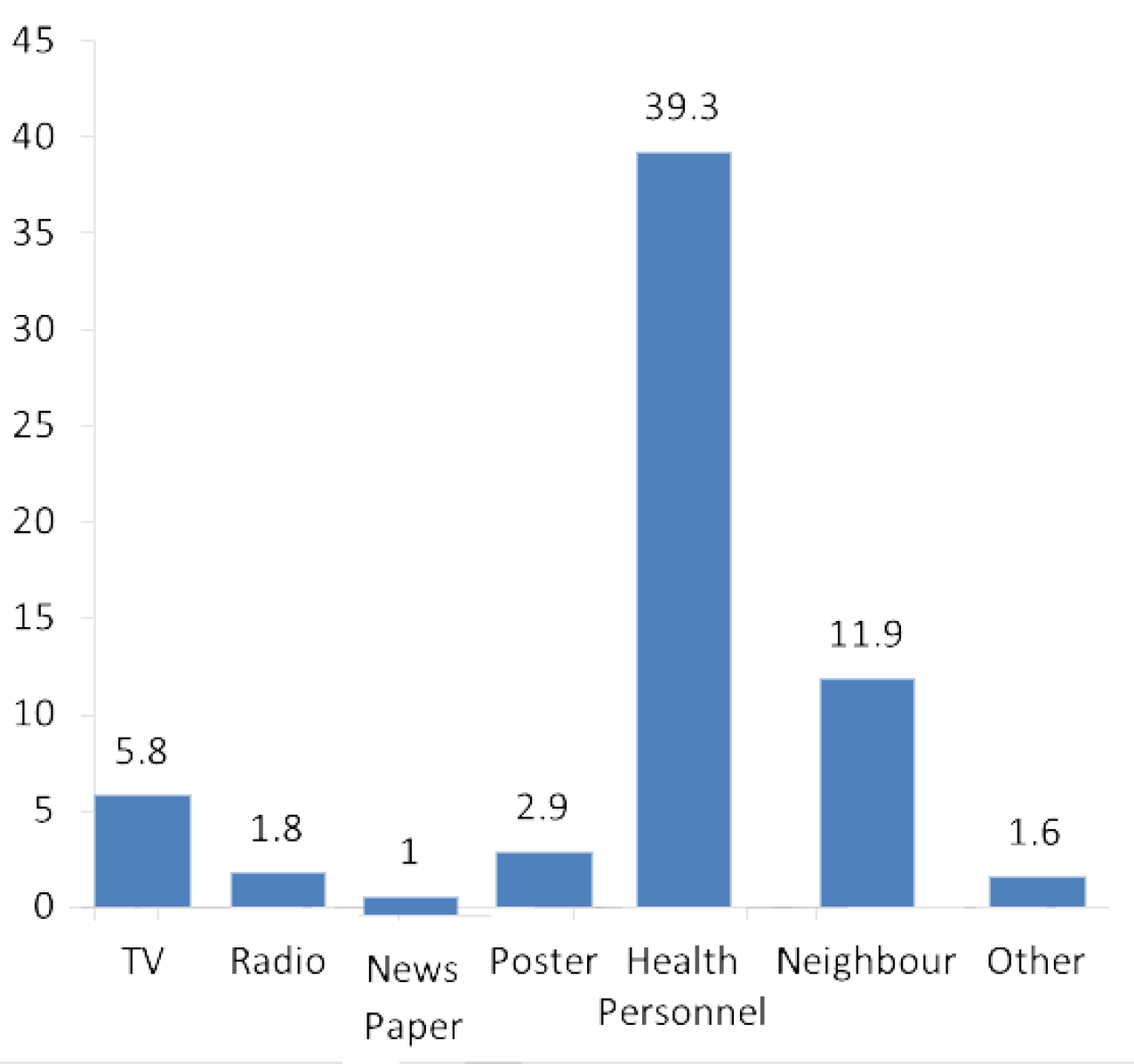Translate this page into:
Are Women Aware about Copper-T? A Comparative Study from West Bengal
Corresponding Author: DR. ANIMA HALDAR, MD. Prof. & Head Department of Community Medicine, NRS Medical College, 138 AJC Bose Road, Kolkata - 700014. Phone No: 03322653333, Extension 1701
Abstract
Background:
The rampant population growth has been viewed as the greatest obstacle to the economic and social advancement to the majority of people in the underdeveloped world.
Objectives:
Comparative study was carried out regarding awareness about Copper-T (Cu-T) and its social correlates among currently married women of reproductive age group in two districts of West Bengal.
Study Design:
A cross-sectional, descriptive type of observational study.
Materials and Methods:
Stratified multistage random sampling technique was followed to select villages of sub-centres areas and wards from municipality areas. Total 32 areas were selected from two districts and from each selected area, 125 eligible couples were interviewed by house to house survey to cover (32 X 125) 4000 eligible couples.
Statistical Analysis:
Proportions and Chi-square test.
Results:
55.9% of currently married women of reproductive age group (15-49 yrs.) had knowledge about Cu-T.only 15.2% had the perception about it Awareness was more among urban respondents (67.3%) than rural (52.1%). Influencing factors like religion, age, literacy status, social class, type of family also prevailed in both the districts of West Bengal.
Conclusion:
Social correlates like age, religion, literacy status, type of family influenced awareness of the respondents about Cu-T. So area specific intervention measures are needed through IEC for genaration of awareness.
Keywords
Eligible Couple
Awareness Copper-T
Social correlates
INTRODUCTION
Family planning services have the potential to improve the quality of the lives of people and also their economic growth. Increasing population growth is a world-wide problem today and India is no exception. A variety of different methods of contraception are available, which are generally extremely safe compared with the risks associated with pregnancy and childbirth.(1) Cu-T is a traditional method of contraception in RCH programme. Cu-T has been introduced in National Family Welfare Programme in 1970.(2) But after 40 years of introduction it has been found that the perception of Cu-T among general population is still lower than the other methods of family planning measures; rather it is decreasing in trend. Knowledge about IUCD in West Bengal has declined from 73% during NFHS-2 to 68% in NFHS-3 (2oo5-2006)3.
The government of India, as part of its commitment towards provision of quality spacing services in family planning, introduced Cu-T 380A in 2002 with an effective protection for 10 years replacing the earlier Cu-T 200.(4) But yet the acceptance of IUCD continues to remain below 2%, out of total couple protection rate of 48.5% for the use of any modern contraceptive method.(4) It was also observed that the contraceptive acceptance rate in West Bengal among currently married women aged 15-49 years is 71%, the use of IUCD is only 1% as per NFHS-3(2005-2006)3. Cu-T acceptance rate is in decreasing trend in majority of the districts of West Bengal in successive years.(5)
The extent of contraceptive practice varies according to cultural factors, age, parity, education, family attitude, motivation, availability and acceptability.(6) Though the Cu-T is considered as an important spacing method, poor knowledge and practice of all possible spacing methods are reflected by lower birth interval. Median interval between births in West Bengal is about 35 months, while 52% of non-first order births occur within three years of the previous birth, including 9% of births that take place within 18 months of previous birth and 22% that take place within 24 months.(3)
In this back ground, the present study was conducted to assess and compare the awareness about Cu-T and its social correlates among currently married women in two districts of West Bengal and to suggest measures for promotion of use of Cu-T in future.
MATERIALS & METHODS
This community-based, cross-sectional study was carried out in rural and urban areas of Paschim Midnapore and Howrah district of West Bengal during March to October ‘09. The sampling technique used was a Multistage stratified random sampling. Two districts were chosen randomly from the 19 in the state of West Bengal, Howrah and Paschim Midnapur.
Out of total blocks in each district, 3 were selected randomly. From each rural block2 sub centers and from each sub center area, 2 villages were selected randomly. Out of total municipalities of the district, 2 municipality areas were selected. From each municipality, 2 wards were selected randomly.
So total 12 villages (4 villages from each block) and 4 wards (2 wards from one municipality) were chosen for study purpose keeping in mind that the rural:
urban ratio in the district was 3:1. So total 16 areas/clusters were selected throughout one district (3 blocks X 4 villages + 2 wards X 2 municipality = 16).
Based on Couple protection rate (50%, as per NFHS-3) in West Bengal, the minimum sample size works out to be 1600 (approx.) considering allowable error 5%. Hence the sample size was fixed at 2000 for one district. From each village/ward, 125 eligible couples were covered to get to the total sample size 2000 from each district. So total 4000 currently married women of reproductive age group constitutes total study population.
Data warecollected using a predesigned and pretested schedule by interviewing the currently married women of reproductive age group in a house-to-house survey using standard random procedures to go to the first house.
Trained faculty members of the Community Medicine Department were involved in the survey. .
The study variables included age of respondent & as well as that of her husband, type of family, Religion, occupation of wife and Husband, literacy status of husband & wife, per capita monthly income, number of living children, current use of contraceptives, knowledge about Cu-T, advantages of Cu-T, source of information about Cu-T. Data analysis & Statistical test done by using Epi -info (3.5.1) software .
Case Definition SOCIAL CLASS – Socio-economic-status of the families was determined from per-capita monthly income.(7) Higher social class: Upper middle (Rs. 3,000-4,999), High (Rs. 5,000-9,999), Upper high (Rs. 10,000 and above) Lower social class: BPL (< Rs. 500), Poor (Rs. 500-1,499), Lower (Rs. 1,500-2,999)
COUPLE PROTECTION RATE –
Percentage of eligible couples effectively protected against child birth by one or the other approved methods of family planning viz – sterilization, IUCD, Condom or Oral pills.(2)
ELIGIBLE COUPLES –
Currently married couple wherein the wife is in the reproductive age (15-49 years).(2)
Awareness – Only heard about Cu-T by the respondents.
Perception – Knowledge present about advantages of Cu-T.
Institutional Education – From primary to graduate and above.
No Institutional Education – Illiterate and just literate.
RESULT
Out of 4000 currently married women of reproductive age group, 2000 were from Howrah and 2000 from Paschim Midnapur district. Most of them were Hindu
(76.9%) by religion; more than 2/3rd (69.9%) belonged to nuclear family, more than half (56.3%) were in the age group of ≤ 29 years, about 2/5th of them (40.1%) had no institutional education and 45.1% belonged to below poverty line (Table-I).
| Social correlates |
Howrah (n=2000) | Paschim Midnapur (n=2000) |
Total No.(%) |
||||
|---|---|---|---|---|---|---|---|
| No of E.C. |
Knowledge about Cu-T No.(%) |
Test of significance |
No of E.C. |
Knowledge about Cu-T No.(%) |
Test of significance |
||
|
1.Religion Hindu Muslim Others |
1336 659 5 |
838(62.7) 408(61.9) 3(60.0) |
X2 = 0.14, df = 2, p = 0.934 |
1740 252 8 |
827(47.5) 155(61.5) 6(75.0) |
X2 = 19.31, df = 2, p = 0.000 |
3076(76.9) 911(22.8) 13(0.3) |
|
2.Type of family Nuclear Joint |
1400 600 |
844(60.3) 405(67.5) |
X2= 9.32, df = 1, p = 0.002 |
1394 606 |
627(45.0) 361(59.6) |
X2 = 35.95, df = 1, p = 0.000 |
2794(69.9) 1206(30.1) |
|
3. Age of Respondents < 18 yrs. 18-23 yrs. 24-29 yrs. 30-35 yrs. ≥ 36 yrs. |
21 491 632 573 283 |
6(28.6) 257(52.3) 406(64.2) 398(69.5) 182(64.3) |
X2 = 44.96, df = 4, p = 0.000 |
23 452 630 526 369 |
6(26.1) 199(44.0) 320(50.8) 265(50.4) 198(53.7) |
X2 = 13.59, df = 4, p = 0.009 |
44(1.1) 943(23.6) 1262(31.6) 954(23.8) 797(19.9) |
|
4. Literacy status of Respondents No institutional education Institutional education |
667 1333 |
334(50.1) 915(68.6) |
X2 = 65.35, df = 1, p = 0.000 |
939 1061 |
327(49.0) 661(49.6) |
X= 0.06, df = 1, p = 0.813 |
1606(40.1) 2394(59.9) |
|
5. Social class Upper high & High Upper middle Lower middle Poor BPL> |
33 33 191 1070 673 |
28(84.4) 23(69.7) 136(71.2) 648(60.6) 414(61.5) |
X2= 15.92, df = 4, p = 0.003 |
1 21 90 745 1133 |
9(81.8) 11(52.4) 61(67.9) 378(50.7) 529(46.7) |
X2 = 20.72, df = 4, p = 0.000 |
44(1.1) 54(1.4) 281(7.0) 1815(45.4) 1806(45.1) |
Observations of the Howrah district:
It was observed that in Howrah district, knowledge about Cu-T was more or less same among Hindu (62.7%) and Muslim (61.9%). Significant variation of awareness about Cu-T observed in relation to type of family, age of respondents, literacy status of respondents and social class in the district of Howrah.Joint family respondents (67.5%) had more knowledge about Cu-T than nuclear family and the difference were statistically significant.Perception also enhanced with the advancement of age. (Table-I).
Knowledge about Cu-T varied in relation to age of the respondents. The trend of awareness about IUCD followed a reverse U-shape, that is, it increased from increasing age 30-35 years and tapered thereafter and the difference was highly significant (p < 0.001). Literacy status of respondents was directly proportional to awareness about Cu-T and it was higher among those who had institutional education (68.6%) (p < 0.05) than non institutional education (50.1%). Awareness about Cu-T was also varied according to their social class and it was statistically significant (p< 0.5) in the district of Howrah.
Table I : Comparison of Awareness about Cu-T in relation to social correlates in two districts of West Bengal (n=4000)
Knowledge about Cu-T varied in relation to age of the respondents. The trend of awareness about IUCD followed a reverse U-shape, that is, it increased from increasing age 30-35 years and tapered thereafter and the difference was highly significant (p < 0.001). Literacy status of respondents was directly proportional to awareness about Cu-T and it was higher among them who had institutional education (68.6%) from primary to graduate & above level (p < 0.05) than Illiterate and Just literate groups where it was 50.1%. Awareness about Cu-T was also varied according to their social class and it was statistically significant (p< 0.5) in the district of Howrah.
Observations of the Paschim Midnapur district:
It was revealed from Table-1 that in Paschim Midnapur district, awareness about Cu-T was more among Muslim (61.51%) than Hindu (47.53%) and the difference was statistically significant (p < 0.05). Significant variation of awareness about Cu-T also observed in relation to type of family, age, literacy status and social class of the respondents in the district of Paschim Midnapur (Table-1). 59.6% of the respondents were aware about Cu-T who belonged to joint families than nuclear families where it was only 45% and the difference was statistically significant (p < 0.05).
Awareness about IUCD (Cu-T) was influenced by age of respondents and the percentage gradually increased with the advancement of age and the difference was highly significant (p ≤ 0.01). Literacy status of respondents had no influence on awareness about Cu-T in Paschim Midnapur district. But awareness was influenced by their social class. Higher the social class more was the knowledge and it was statistically significant (p ≤ 0.05).
Overall observations:
Out of total study population, 55.9% of respondents were aware about Cu-T (Fig .I),

- Awareness about IUCD (Cu-T) in the state of West Bengal (n=4000)
but only 15.2% knew the advantages of it. Fig.II showed area wise knowledge about Cu-T among respondents in two districts. Urban respondents were more aware (67.3%) than the rural (52.1%).

- AREA WISE AWARENESS ABOUT Cu-T AMONG RESPONDENTS IN TWO DISTRICTS (n=4000)
In Howrah district less awareness observed in rural area (42.9%) than urban area (69%) but in Paschim Midnapur district there was less variation (rural 61.4% and urban 65.5%).
Regarding source of information about IUCD, most common source of information was Health personnel (39.3%) followed by neighbour/relatives (11.9%), TV (5.8%), poster (2.9%) and others (1.6%) shown in Fig.III.

- SOURCE OF INFORMAT ION* (Multiple response) OF IUCD (Cu-T) (n=4000)
The present Community based cross sectional study was conducted in two selected districts of West Bengal covering 4000 eligible couples to assess the awareness about Cu-T and its social correlates among currently married women of reproductive age group. Overall awareness was found 55.9% only in the present study. But perception regarding Cu-T was present only 15.2% of the study population Study conducted by H Suhaimi, D Monga, A Siva (8) good knowledge about IUCD among health care staff was found to be only 22%. Renjhen et al (9) showed 72% awareness about IUCD and 47% awareness about IUCD was revealed by Tuladhar and Marahtta study (1)
The present study revealed that less awareness about Cu-T among rural women (52.1%) than urban women (67.3%) in the state of West Bengal. The findings of the present study did not corroborated with the findings of earlier studies.(1,6) Knowledge about Cu-T was higher (85.5%) in case of Tafila - Jordan study (6) but it was quite less (55.9%) than the finding of the current study.
The urban rural variation was found to be greater in Howrah than Paschim Midnapur. It was revealed that other variables like religion, age, literacy status, social class, and type of family significantly influence awareness about Cu-T among married women of reproductive age group in both the districts of West Bengal. But in Howrah district the influence of religion was not statistically significant, whereas in Paschim Midnapur, Muslim respondents were found to be more aware than Hindu. The higher awareness among Muslim respondents may be attributed to lesser no of Muslim study population.
Though in Howrah district percentage of literate respondents were more (66.7%) than the Paschim Midnapur (53.1%), but awareness about Cu-T was greater in Paschim Midnapur (63.5%) than the Howrah (55.9%) district. It indicates performance of health personnel (major source of information) in the district of Paschim Midnapur was better than Howrah district.
IUCD was found to be preferred by the younger age group and less educated women shown in earlier study by Najla Nour Thalji (6) but the reverse was elicited by the present study.
In the present study, most common source of information about Cu-T was Health personnel (39.3%). But this findings did not corroborated with the findings of previous study by Tuladhar and Marahtta, (1) which revealed that the main source of knowledge was mass media as reported by more than half (55.5%) of the respondents. Most of other studies also have stated that print and electronic media to be the common source of public awareness 57.7% (10) and 50.0%.(9) In contrast, Korean study (11) revealed the main source of information to be health center or relatives and neighbors. It had been reported by another study (12) conducted in Manipur, India that major source of information was friends (44.0%) and mass media (22.0%). But contribution of mass media (11.5%) as a source of information was very less in the present study.
In the present study in both the districts, awareness about Cu-T was higher among the respondents’ belonged to higher social class, higher age group and joint families. In comparison to literacy status of the respondents, in case of Paschim Midnapur district literacy had no role for awareness about Cu-T whereas in Howrah district institutional educated group were more aware about Cu-T than no institutional educated group.
Presence of overall perception about Cu-T was only 15.2% out of total 55.9% aware currently married women in the present study. A sustained and coherent IEC is required which will high light the advantages of this spacing method may enhance the perception of the general population for promotion of IUCD acceptance.
It has been observed from from the present study that awareness through mass media was minimum. So to enhance community awareness about IUCD (Cu-T), advocacy through Television, Radio and display of posters/hoardings at the specific places (key points of village, Gram Panchyat Office, all entry point of all sub-centers, Health Centers and all hospitals) to be needed along with interpersonal communication.
REFERENCE
- Awareness and practice of family Planning methods in women attending Gyne OPD at Nepal Medical College Teaching Hospital. Nepal Med Coll J. 2008;10(3):184-191.
- [Google Scholar]
- Ministry of Health & Family Welfare, Nation Family Health Survey (NFHS-3) India- West Bengal 2005-06, International Institute for population Sciences. Deonar, Oct 2008:6-7.
- [Google Scholar]
- IUCD Reference Manual for Medical Officers, Family Planning Division, Ministry of Health & Family Welfare, Govt. of India 2007:1-4.
- [Google Scholar]
- Knowledge, attitude and practice of women towards family planning methods in Tafila-Jordan. JRMS. 2003;10(1):40-44.
- [Google Scholar]
- The need to update in the present Scenario. IJCM. 2008;33(1):50-51.
- [CrossRef] [PubMed] [Google Scholar]
- A study of knowledge and attitudes towards contraception among health care staff in Kelanthan (Malaysia) Singapore Med Journal. 1996;37:51-54.
- [Google Scholar]
- A Study of knowledge, attitude and practice of family planning among the women of reproductive age group in Sikkim. J Obstet Gynecol India. 2008;58:63-7.
- [Google Scholar]
- Contraceptive practices and awareness of emergency contraception in educated working women. Indian J Med Sci. 2005;59:143-9.
- [CrossRef] [PubMed] [Google Scholar]
- Center for Population and Family Planning. Benchmark survey report on community based distribution of contraceptives in Korea. . 1976;51
- [Google Scholar]
- Knowledge, attitude and practice of family planning: A study of Tezu village, Manipur (India) The Internet J of Biol Anthropol 2007
- [Google Scholar]






